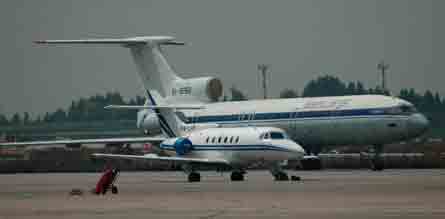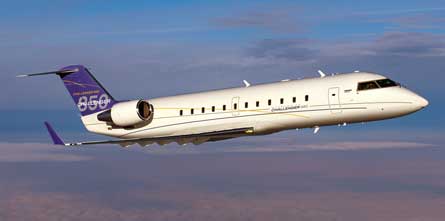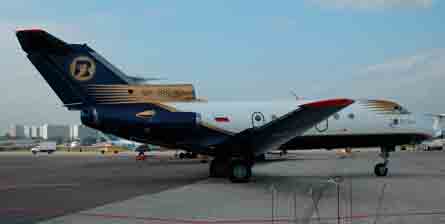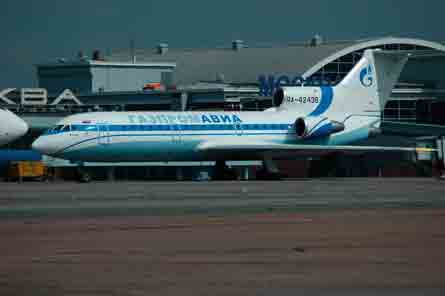A few years ago, no-one could have imagined Russia as one of the world’s fastest-growing markets for business aviation. But can its creaky infrastructure keep pace?
Fifteen years after the collapse of the Soviet Union, Russia is emerging as a major player on the business aviation stage and the country’s size and diversity has become both a major draw and a challenge for leading Western suppliers and industry groups.
|
|---|
Western built business jets are commonly placed on foreign registers |
Business aviation began to take root during Russia’s privatisation years of the 1990s, when the concept of personalised, flexible transport developed the thirst of a new breed of entrepreneur, notably the oligarchs who acquired vast interests in the energy and media sectors and became millionaires overnight. They began to snap up and convert to VIP use fleets of mainly Soviet-built airliners, hundreds of which were abandoned following the collapse of the Soviet Union.
Significantly, the new political order, under the stewardship of President Vladimir Putin, has provided the country with steady economic growth. This in turn has swelled the ranks of high net-worth individuals who are turning to business aviation to satisfy their transport needs and feed their appetites for high-end products that have become visible symbols of wealth, privilege and success.
Turnover growing
According to a recent study by market research group Ros Business Consulting, business aviation traffic in Russia has grown by up to 50% in the past two to three years, while its turnover has risen from $750 million in 2004 to $1 billion last year and is expected to continue its climb.
The Boston Consulting Group (BCG), in a report issued last month, says Russia can expect to see personal financial wealth grow faster than anywhere else on the planet, after India. It says: “Boosted by the flood of cash from oil and gas exports, the value of stock bonds and other financial assets held by Russians will grow at 12% a year through to 2010.”
A similar conclusion was drawn by investment managers Merrill Lynch, which found the number of millionaires in Russia grew by 17% in 2005 – the third-largest increase after South Korea and India.
Forbes magazine says more than half of Russia’s millionaires live in or around Moscow, which is also home to its highest concentration of billionaires. It is no coincidence, therefore that the Russian capital has become the nucleus of business aviation activity in the country. Moscow’s airports handle more than 100 business aircraft flights a day, far above the European average, says Russian business aviation association ADA, adding that business aircraft flights to and from Moscow are growing by 30% a year.
|
|---|
A Russian owner became the first Challenger 850 customer last month. |
Artyom Pastukhov, Vipport operations director, says: “We are seeing our annual movements grow at around 50%. In 2000 we averaged five flights a day. Now we handle around 80 and this number is increasing.” The company has opened a new business aviation terminal and is increasing its hangar capacity and ramp space threefold to accommodate increasing numbers of aircraft.
A new highway connecting the airport to the centre of Moscow has been funded and constructed by the city of Moscow to improve journey times. As a security precaution this road is closed 1h before a government flight is due to depart, which can increase time pressures on busy executives.
The road network can also be a major headache for Sheremetyevo, 29km north-west of Moscow, and East Line Group-operated Domodedovo, which is also looking to expand its business aviation services.
East Line says the congested highways that lead from the city to Domodedovo, 45km south-east of Moscow, can lead to journey times of more than 2h at peak periods, which is not conducive to business aircraft travel. While the train to the city has become an efficient alternative, executives are looking for speedy access. Daniel Burkard, business development director for East Line, says: “We are looking to develop, in collaboration with the city of Moscow, a helicopter service that will operate along corridors to predesignated landing pads near the centre. We plan to extend this service outside Moscow.”
Domodedovo handles around 120 business aircraft movements a day, and is “developing this segment”, Burkard says. “We are seeking up to two partners to develop a one-stop shop for visitors, including a fixed-base operation and maintenance facility for all business jet types.”
Although business aircraft movements are on the rise at state-owned and operated Sheremetyevo, the airport has limited space and, some argue, interest, in growing the business.
The airport is home to flag carrier Aeroflot Russian Airlines and its business aircraft subsidiary Aeroflot Plus. Sheremetyevo is also the base for all government flights, as well as its own corporate aircraft fleet, which includes two Tupolev Tu-134s, two Yakovlev Yak-40s, one Yak-42, two Embraer Legacys, four Raytheon Hawkers and a Dassault Falcon 20. “We looking to expand our operation here, but there is very little interest in developing business aviation, even though the demand for our services continues to increase,” says Mikhail Pivovarov, Aeroflot Plus adviser.
Western operators including Jet Aviation, London Executive Aviation and TAG Aviation are all reporting increasing demand for charter services to and from Russia. Swiss VIP charter and management company Comlux, in response to an “overwhelming demand” for its large-aircraft charter services, has established a sister company in Moscow to market and sell its product directly to Russian clients.
The appetite for fractional ownership is also increasing, according to NetJets Europe, which boasts a customer base of 80 owners in Russia. “During 2005 our aircraft made around 1,000 departures in Russia, while this August alone we made 900 and expect overall movements for the year to be around 85% higher than last year,” says NetJets Europe business development manager Robert Dranitzke.
The demand for charter services prompted the city of Moscow last year to unveil ambitious plans for an air-taxi network linking the capital to major suburban areas in Russia and cities in Europe starting late next year. Local government has allocated Rb27 million ($1 million) to establish a detailed draft plan that includes flight operations and a fixed-base operation in Moscow and its outlying areas. The entire programme is expected to cost up to €730 million ($930 million).
Russia wakes up
“Russia is a vast country crossing 11 time zones. It is awakening to the benefits of business aviation,” says Rustam Kurdjiev, head of marketing for Moscow-based aircraft broker Ural VIP Avia. Like its Western counterparts, the three-year-old company has witnessed increased demand for charter services, particularly within Russia. Kurdjiev says: “The collapse of the Soviet era drove hundreds of airlines out of business, which meant that many parts of the country were no longer accessible by air. Business aircraft provided a lifeline to many of these areas, some of which are bases for Russia’s [lucrative] natural resources, including timber and mining.”
While charter and fractional operations have become an integral feature of Russian business aviation, the demand for outright ownership is intensifying. According to data compiled by Flight International’s sister data service Flight Acas, Russia’s corporate aircraft fleet totals around 200 aircraft and largely consists of converted Russian and Ukrainian-built airliners – part of the fleet of aircraft parked and abandoned following the end of the Cold War.
Many of these have been incorporated into fleets of Russian oil companies such as Lukoil – which operates three Yak-40/42s – and Gazpromavia, which doubles as an aircraft operator with a fleet of five Antonov An-74s, three Yak-40/42s and one Tupolev Tu-154. The operator also has a handful of Western types including a Falcon 900EX.
|
|---|
Old Russian aircraft such as the Yak-40 still make up the bulk of the corporate fleet |
Ageing Russian aircraft are typically used to service the domestic markets as they do not comply with European Union Chapter 3 noise and emission requirements. “They are no longer seen as desirable,” says the ADA. “Wealthy customers, particularly those who travel internationally, are looking to the new generation of Western aircraft that not only provide operational benefits, but offer a much higher level of comfort than their Russian counterparts.”
All the major Western airframers have made an impact on the Russian market. Dassault achieved the first sale to the region in 1993 with the delivery of a Falcon 50. Raytheon followed soon after with the first Hawker 125-series mid-size jet. Today, around 100 business jets worth around $1 billion have been sold to Russian customers, and a further 70 aircraft are expected to be added by the end of the year, says the ADA.
Bombardier is among those making significant inroads, having sold 55 business jets in the country in the past 27 months – 30 of them in the past year, says Bob Horner, executive vice-president of sales for Europe, the Middle East, Africa, and India. Horner says Russian buyers are particularly interested in large-cabin aircraft, including the Global Express, the first of which was sold to a Russian customer eight years ago, and the Challenger series. A Russian customer last month became the first recipient of a Challenger 850, the corporate derivative of the CRJ200 regional jet.
Embraer tells a similar story. The Brazilian airframer expects to have up to 10 Legacys flying in Russia by the end of the year and has earmarked the country as “a significant market for the new Lineage 1000”, says Luis Carlos Affonso, Embraer’s senior vice-president executive aviation.
Airbus, meanwhile, has sold four A319 Corporate Jetliner widebody business jets to Russian customers in the past 12 months.
Cessna and Raytheon, although specialising in the entry level to super mid-cabin arena, accept the view that large-cabin aircraft are most popular, yet suggest the market is becoming more diverse as wealth begins to trickle down. “There is a lot of wealth creation in Russia and many people who do not have pockets as deep as the rich tycoons are looking at smaller-cabin aircraft like the Beechcraft Premier I, in which we are beginning to see a lot of interest,” says Steve Morgan, regional sales manager for Raytheon, which has around 15 aircraft flying in Russia.
Cessna popular
Cessna, which made its footprint in Russia eight years ago following the delivery of a Citation Bravo, says it is witnessing a shift in the market towards its product range: “We are seeing encouraging growth in demand for our products,” says Tom Perry, Cessna’s regional sales manager. “To date, the superlight XLS, mid-size Sovereign and Citation X have proved most popular with Russian customers.”
Although Russia is fertile territory, a restrictive tax on imported aircraft is a frustration. “It is very expensive to register foreign-made aircraft because of exorbitant customs duties, which total around 40% of the aircraft’s value. This is now a major concern for operators and foreign manufacturers,” says Eric Weisskopf, Comlux head of special operations.
Consequently there are only 13 Western-built corporate jets on the Russian register, according to Flight Acas data. “These taxes, which also affect spares and engines, were designed to protect the Russian aircraft industry against massive foreign imports, but we don’t have much of a manufacturing industry any more,” says Ural VIP Avia’s Kurdjiev.
The Russian government hints that it may scrap the duty next year. In an interview with Russian aviation magazine JET, the country’s transport minister Igor Levetin declared his support for its abolition. “Estimates show that around 200 business jets are directly or indirectly owned by Russian companies. These are the aircraft that account for most business aircraft flights in Russia,” he said. VAT abolishment will provide an opportunity to register those jets in Russia, which will allow them to operate internal flights without falling foul of cabotage restrictions.”
The majority of Russian aircraft are registered in Aruba, Austria, Bermuda, the Cayman Islands and Luxembourg, where registers have grown in line with sales of aircraft in Russia (see graph). Jorge Colindres Marinakis, president and chief executive of the International Air Safety Office of the Registry of Aruba, says: “We have been actively promoting the benefits of our register, on which we now have over 100 aircraft. Although there are obvious tax benefits, many owners are drawn to our register because of the attention we pay to service and safety oversight. They don’t feel as comfortable with the Russian system because there are no clearly defined rules for business aviation.”
This is a sore point for Russia’s business aviation community, anxious to clean up its image, which is becoming tainted through corruption. “Demand for business aviation is escalating, but the operational and regulatory infrastructure to support the industry, particularly outside Moscow, is limited,” says East Line’s Burkard. “Business aviation is still very new here, and there is little understanding or appreciation of our market. Without clearly defined rules the industry will continue to be open to corruption,” he says.
Tackling extortion
One company, which does not wish to be identified, says: “Nothing is simple in Russia. If people have power over you, however small, they can always find a way to extort money. It is not unusual to be told ‘you don’t have the right paperwork’ and will have to part with a handful of cash to leave the airport. Other times you may be refused a visa for no apparent reason, forcing you to abandon your trip.”
Another company says: “With so many layers of government bureaucracy, decisions can take a long time or simply not happen. They take you for a ride and then wait for the next sucker to come along.”
Burkard says: “It is only 15 years since the breakdown of communism and many people are living on low wages. It is tempting to supplement their incomes through corruption. If you are travelling for business in Russia it always helps to have friends in high places.”
|
|---|
Oil company Gazpromavia includes converted Russian airliners in its corporate fleet |
ADA is promoting a $1 billion programme, for which it is seeking government and private backing, to reform the business aviation infrastructure in Russia. Objectives include developing by 2010 a network of modern airports at key strategic cities – at Ostafevo in Moscow; Pulkovo in St Petersburg; Koltsovo in Yekaterinburg; Rostov-on-Don; Sochi; Novy in Khabarovsk; Knevichi in Vladivostok; Tolmachevo in Novosibirsk; and Emelianovo in Krasnoyarsk. These are intended to promote the growth of maintenance and service centres “to satisfy demand from Russian and foreign customers for end-to-end servicing of business aircraft”.
The current offering, industry argues, is poor and weighted in favour of Soviet-built aircraft. Western designs are maintained at established centres outside Russia. Lufthansa Bombardier Aviation Services signed a letter of intent earlier this year to provide maintenance at Vnukovo 3 for Bombardier types, while Gazpromavia is seeking to establish a new maintenance facility at its Ostafevo base, which it says will serve “a range of Western types”.
The plan also seeks to develop a regulatory and legal framework based on international standards and best practice consistent with the International Standards for Business Aircraft Operations (ISBAO) established by the International Business Aviation Council and to also bring Russian aircraft certification standards in line with international standards, which it hopes will encourage more airframers to pursue Russian approval for new aircraft.
While the industry works to improve the operating infrastructure, the government has pledged to help Russia’s beleaguered aircraft manufacturing industry, a move that could have a positive impact on the manufacture of business aircraft.
Over the next 10 years, Russia’s aircraft designs will be dragged into the 21st century, boosted by the creation this year of new aerospace holding company United Aircraft (UAC), formed from the merger of eight aircraft plants and five design bureaux. The government, a 75% stakeholder in the new aerospace giant, has pledged to invest over $13 billion in UAC to help re-establish the country’s position as a major player on the aviation stage. Although Russia still accounts for around 25% of the global market for military aircraft, its industry has only 1% of the world market for civil aircraft, producing around a dozen aircraft annually. As business aviation continues to grow, some manufacturers may be persuaded to dust off their aircraft designs and enter the market.
Alternatively, as Russia moves to loosen restrictions on foreign participation in commercial aircraft projects, this could provide another means to gather investment or establish joint ventures on new products. Under the proposed rules, foreign companies would be allowed to own stakes of up to 49% as opposed to the current 25%.
Although business aviation is in its infancy, Russia has become a major draw. As the wealthy elite continues to expand over the next decade and industry strives to modernise, Russia could match the USA as a major force in business aviation. ■
Source: Flight International























